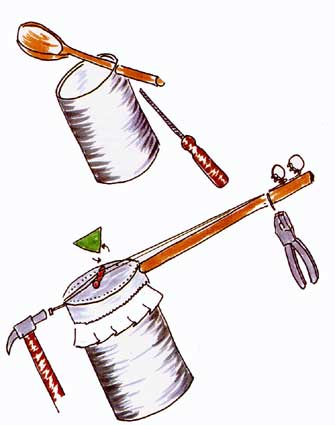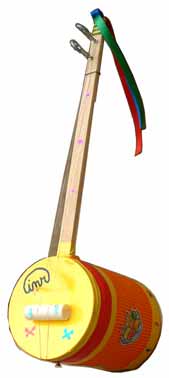|
|
 |
BANJO
ONCE UPON A TIME...
If one day- you find yourself reading a magazine or watching television and you see a musical instrument of the chordophone or string type (guitar, ukulele, etc.) which has a round sound box, reminiscent of a DRUM, this instrument is almost certainly a member of the BANJO family. BANJOS can have different names depending on their size and the number of strings they have. It was very probably the American settlers who introduced the BANJO into Portuguese popular culture, giving rise to the first JAZZ BANDS. Yet, the BANJO is still closely linked to ďAlentejoĒ music, in which the barber is traditionally the main player.
MATERIAL NEEDED
A round tin can, a wooden spoon, a sheet of strong plastic, some wire, two screw-in hooks, roughly 5 cm plastic tube (an old pen) and some nylon thread for the strings.
TOOLS AND ACCESSORIES
A saw, a pair of scissors, a hammer, a punch, a file, 3 meters of string, a general purpose pair of pliers and a nail.
HOW TO MAKE THE INSTRUMENT
Make a hole in the side of the can, so that you can stick the wooden spoon into it with the bigger end inside the can. To make the structure more solid, nail this part of the spoon to the can. When you do this, take care to make sure that the spoon is level. In other words, it must be at right angles to the can. After this, cover the open part of the can with some plastic sheet and stretch this tight (this operation is easier to perform if you have someone to help you). Screw the two hooks into the top of the spoon. When you hammer in the nail to fix the spoon in place, leave roughly one millimeter sticking out. You can then use this space for tying the two strings onto. The other end of the string is going to be wound round the respective hook, which will then be used for stretching (or tuning) the string. However, so that the string makes a good loud and well-tuned sound, it needs to be supported at two points. Use the wire to hold the string in place next to the hooks, wrapping it round the spoon as well. The other support for the string is the small pen tube, which you should place on top of the canís plastic cover.
DECORATION
In the old days, the student bands at Portuguese universities used to stick cloth ribbons on the instruments they were playing. These had different colours, depending on which course the students were studying. Another suggestion for decorating your can is to use cardboard strips, with different alternating colours. But youíre the one who knows best. Decorate your BANJO just as you want to. But, when you finally get to college yourself, remember to keep this tradition alive and use the colours of your course.
HOW TO PLAY THE INSTRUMENT
The toy that youíve just made will make it possible for you to play different sounds, but it wonít enable you to play a tune, because there is no tempered scale. Later on, Iíll teach you how to do this.
